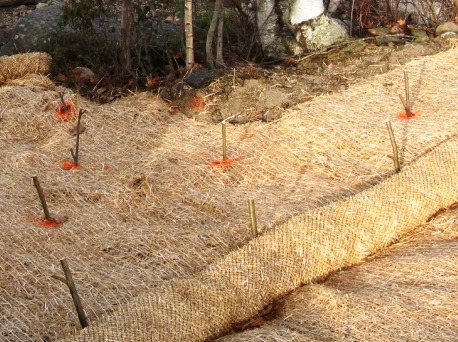Live Stakes / Pole Plantings

Description
Live cuttings from plants can be used to re-establish vegetation on streambanks, providing erosion control and other benefits. Live stakes (cuttings) and pole plantings are living plant cuttings from species that root quickly, such as willow and cottonwood. The plantings grow almost immediately and form a protective layer to help prevent soil erosion. This layer is a living root mat that stabilizes the soil by reinforcing and binding soil particles together and by extracting excess soil moisture. This is a low-cost, highly effective BMP that can be easily installed and maintained on a wide variety of sites.
Applicability
This practice is applicable on all sizes of streams and for a wide range of bank characteristics. It is most appropriate where erosion is light and washout is unlikely. Live staking is a preventative measure and should be employed before severe erosion problems occur. Because live plant cuttings are more resistant to erosion than traditional seeding techniques, it is beneficial to use them on the lower portions of the bank to moderate flow velocities. They can enhance the performance of surface erosion control materials, create favorable conditions for natural colonization of vegetation from the surrounding plant community, stabilize intervening areas between other soil bioengineering techniques (such as live fascines), and produce streamside habitat.
Effectiveness
This practice should be used jointly with other restoration techniques, especially on slopes with high erosion rates. Because this is practice employs live vegetation, success is also dependent on the selection of appropriate plants for the site environment (see design considerations).
Maintenance
Once the stakes have grown and become established, no maintenance is necessary (Heaton et al 2002).
Costs
In addition to the cost of stakes, which are installed at a density of 2 to 4 live stakes per square yard at about $2.00 per stake, costs will include tools (e.g. hand pruners, clippers, untreated twine, deadblow or rubber hammer) and burlap sacks (moistened and lined with wet leaves or mulch). Pole plantings will cost slightly more due to their larger size. Small projects, involving 100-200 feet of streambank, will require about 4 to 5 large (3/4 ton) truck loads of plant materials (Riley 1998). To reduce labor costs, use volunteers. A single volunteer can install up to 75 stakes an hour (Heaton et al 2002).
Design Considerations
- Installation is best accomplished in late fall at onset of plant dormancy, in the winter as long as the ground is not frozen, or in early spring before budding growth begins.
- Vegetative cuttings are living materials and must be handled properly to avoid drying or exposure to heat. They must be installed in moist soil and adequately covered with mulch. Soil must be tamped to eliminate or minimize air pockets around buried stems.
- The recommended slope is < 3:1. This practice is not applicable for slopes > 2:1.
- Pole plantings are similar to live stakes, but a bit larger (4-10 feet long, whereas stakes may be 1/5-4 feet long), and tend to survive longer (Riley 1998).
- Applicable with other structural methods. Planting should occur on natural bank soil, not fill.
- Plantings may need to be fenced or protected from wildlife (beavers, deer, etc.).
References
Caulk, A. D., J. E. Gannon, J. R. Shaw and J. H. Hartig. 2000. Best Management Practices for Soft Engineering of Shorelines. Greater Detroit American Heritage River Initiative, Detroit, Michigan.
http://www.tellusnews.com/ahr/report_table_contents.html
Heaton, M. G., R. Grillmayer and J. G. Imhof.2002. Ontario’s Stream Rehabilitation Manual. Ontario Streams, Belfountain, Ontario.
http://www.ontariostreams.on.ca/
Kelley, F. 2001. Restoration of Urban Streams. United States Department of Agriculture,
www.state.nj.us/dep/watershedmgt/DOCS/Restoration%20of%20Urban%20Streams.pdf
MDE. 2000. Maryland’s Waterway Construction Guidelines. The Maryland Department of the Environment Water Management Administration,
http://www.mde.state.md.us/wetlands/guide.html
PADER. 1986. A Streambank Stabilization and Management Guide for Pennsylvania Landowners. Commonwealth of Pennsylvania Department of Environmental Resources (PADER), Office of Resources Management, Harrisburg, PA.
Riley, A. L. 1998. Restoring Streams in Cities: A Guide for Planners, Policymakers and Citizens. Island Press. Washington, DC.
USDA-FS. 2000. Soil Bioengineering: An Alternative for Roadside Management. United States Department of Agriculture, Forestry Service, Technology and Development Program, San Dimas, California.
http://www.or.blm.gov/nrst/Reference/Soil%20bioeng.pdf
LCSMC and USDA-NRCS. 2002. Streambank and Shoreline Protection Manual. Lake County (Illinois) Stormwater Management Commission and USDA-NRCS.
http://www.co.lake.il.us/
Recommended Fact Sheets and Resources
FISRWG. 1998. Stream Corridor Restoration: Principles, Processes, and Practices. Federal Interagency Stream Restoration Working Group,
http://www.usda.gov/wps/portal/usdahome
USEPA. Restoration Bi-Weekly Update. United States Environmental Protection Agency, Office of Water. Accessed 7/03/02.
http://www.epa.gov/owow/wetlands/restore/update/